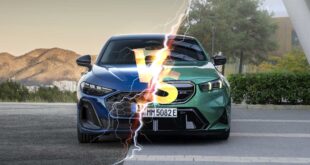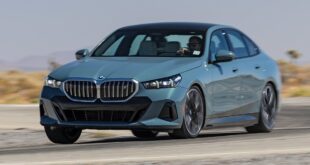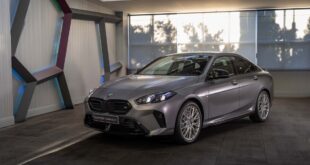 Despite mostly positive reviews for the BMW i3, Road & Track tests the car and is not entirely impressed. The U.S. publication went to Munich for a quick 15 minute drive of the car and this is an excerpt of what they had to say:
Despite mostly positive reviews for the BMW i3, Road & Track tests the car and is not entirely impressed. The U.S. publication went to Munich for a quick 15 minute drive of the car and this is an excerpt of what they had to say:
Our time at the wheel consisted of 15 minutes on a cone course. The first thing I scribbled into my notebook: “This ain’t no Tesla. It’s not a BMW, either.â€
Threading an i3 through a slalom feels like autocrossing an X5 on snow tires three sizes too narrow. The battery pack is mounted in the floor, Tesla-style, helping to keep the center of gravity low, but you’d never know it. The tall body cranks into the air, lists like a sailboat, and settles into tire-chattering understeer at what feels like a walking pace.
Tire size can’t help. The i3′s low-rolling-resistance, 155/70R-19 Bridgestones are nearly 1.5 inches narrower than the rear tire on BMW’s S 1000 RR motorcycle. The 1970s-tall sidewall is likely a boon to ride quality, as is the lack of a rear anti-roll bar, but it does the chassis no favors.
BMW says weight distribution is nearly 50/50 front-to-rear, but there’s no balanced behavior here. The overboosted steering is devoid of feedback, and at high speed, the understeer becomes snap oversteer paired with pucker-worthy stability-control interventions that seem to be the only thing keeping the car’s wheels on the ground.
At least the brakes feel great. The i3 uses Tesla-style accelerator mapping (full regeneration hits when you come off the gas), leaving a brake pedal free of the typical unpredictability of a blended brake system. The 11,000-rpm electric motor uses a clever magnet design that helps power production at high shaft speeds. Consequently, the i3 is quick to its 93-mph top speed, and BMW says 60 mph arrives in around seven seconds.
 BMW.SG | BMW Singapore Owners Community The Ultimate BMW Community – Established Since 2001
BMW.SG | BMW Singapore Owners Community The Ultimate BMW Community – Established Since 2001













